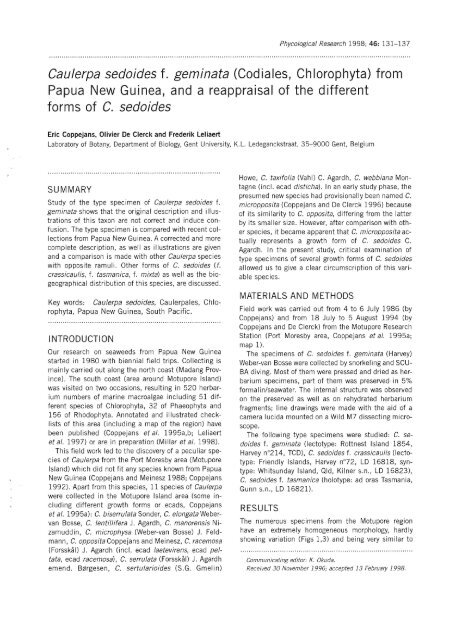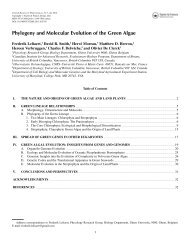Caulerpa sedoides f. geminata - Phycology Research Group, Ghent ...
Caulerpa sedoides f. geminata - Phycology Research Group, Ghent ...
Caulerpa sedoides f. geminata - Phycology Research Group, Ghent ...
- No tags were found...
You also want an ePaper? Increase the reach of your titles
YUMPU automatically turns print PDFs into web optimized ePapers that Google loves.
136E. Coppejans et al.to obovate ramuli; the other specimens (n° 214 left up,n° 559a and unnumbered) belong to C. <strong>sedoides</strong> f. <strong>sedoides</strong>with obovate ramuli in all directions along therachis. No intermediates are present on this sheet.<strong>Caulerpa</strong> fergusonii Murray is similar to C. <strong>sedoides</strong>f. <strong>geminata</strong>, but the type specimen in Leiden (L930.139-10; Ferguson Ceylon Algae n° 415) exhibitsa clearly articulated rachis with marked, ring-like constrictionsand ovoid to clavate ramuli (pers. obs.) whichalso have been described and illustrated by Murray(1891, p. 212, pI. 53, fig. 1), Weber-van Bosse (1898,p. 389, pI. 34, fig. 12), Taylor (1967, p. 48, fig.3)Kajimura (1975, p. 24) and Coppejans andPrud'homme van Reine (1992a, p. 690, figs 1D,E,13A,B).Weber-van Bosse (1913, p. 112, fig.29) illustratedspecimens of C. fergusonii without articulations, the illustrationshowing circular, dorsiventrally compressed,paired ramuli, looking like young C. <strong>sedoides</strong> f. <strong>geminata</strong>specimens. Examination of these specimens (L937.333-88) in Leiden confirmed their identificationas C. fergusonii. <strong>Caulerpa</strong> zeyheri Kützing is markedlysmaller and more elegant than C. <strong>sedoides</strong> f. <strong>geminata</strong>the erect branches being only 0.8-1.3 cm high accordingto Sartoni (1978, p. 412, fig. 5D), the ramuli arepyriform and successive pairs are overlapping. Thespecimens of C. zeyheri reported by Taylor (1967) fromMozambique correspond very well with our materialfrom Tanzania (Zanzibar), with a marked naked basalpart of the rachis and turbinate to pyriform ramuli, butare different from C. <strong>sedoides</strong> f. <strong>geminata</strong> beca use ofthe absence of pyrenoids. The general morphology of<strong>Caulerpa</strong> opposita Coppejans and Meinesz is quite similarto C. <strong>sedoides</strong> f. <strong>geminata</strong> but the former speciesis much coarser (Fig. 9). No specimens with intermediatesizes between C. opposita and C. <strong>sedoides</strong> f. <strong>geminata</strong>have been found. Both species have plastids witha pyrenoid. <strong>Caulerpa</strong> buginense Verheij andPrud'homme van Reine (1993, p. 392) also is somewhatsimilar to C. <strong>sedoides</strong> f. <strong>geminata</strong>, but the ramuliof the former species are flat and successive pairs oframuli are markedly overlapping. The illustrations of C.manorensis Nizamuddin by Nizamuddin (1964, p. 216)and Shameel and Shaukat (1992) appear to be similarto C. <strong>sedoides</strong> f. <strong>geminata</strong> but the former is differentfrom the latter by having a compressed rachis andbranchlets.Apart from C. <strong>sedoides</strong> f. <strong>geminata</strong>, three more formshave been described: C. <strong>sedoides</strong> varo tasmanica J.Agardh (1873, p. 40) after material from Tasmania andlater considered as a forma by Weber-van Bosse, C. <strong>sedoides</strong>f.tasmanica (J.Agardh) Weber-van Bosse (1898,p. 387). Examination of the type specimen(Figs 17,18) proves it to be a rather lax growth form ofC. <strong>sedoides</strong> f. <strong>sedoides</strong> and easi Iy fits in the morphologicalrange of this variable species. <strong>Caulerpa</strong> <strong>sedoides</strong>varo crassicaulis J. Agardh was described after a Harveyspecimen from Tonga (Friendly Islands) and materialfrom Whitsunday Island, Queensland. Weber-van Bosse(1898, pp. 387-380) selected the Harvey specimen aslectotype (Fig. 19) and reduced this variety to a forma,C. <strong>sedoides</strong> f. crassicaulis (J. Agardh) Weber-van Bosse.However, re-examination of the type material revealedthat this forma did not belong to the C. <strong>sedoides</strong> complex,but that it should be considered as C. lentilliferaJ. Agardh varo kilneri (J. Agardh) Weber-van Bosse. Themost conspicuous character differentiating C. <strong>sedoides</strong>and C. lentillifera lies in the shape and placement ofthe ramuli. The ramuli of C. lentillifera are absolutelyspherical whereas those of C. <strong>sedoides</strong> or either oblongateor dorsoventrally compressed¡ moreover, they areplaced on fairly regular, dense, longitudinal rows in theformer (Coppejans and Meinesz 1988, figs 39,40),whereas they are generally loosely and irregularly placedin the latter (Womersley 1984, p. 255). The variety kilneriis characterized by short, subconical pedicels,whereas the pedicels of the typical C. lentillifera specimensare much longer and subcylindrical (Cribb 1958,pp. 213-214). The morphology of the pedicel does notdifferentiate between C. <strong>sedoides</strong> and C. lentillifera varokilneri, nor does the presence of a pyrenoid. It is noteworthythat the original description of C. lentillifera varokilneri was based on a specimen collected by Kilnerfrom Whitsunday Island, the syntype locality of C. <strong>sedoides</strong>f. crassicaulis (Figs 20,21). Svedelius (1906,pp. 139-140) reported C. <strong>sedoides</strong> f. crassicaulis fromSri Lanka, but it should be confirmed whether the specimeneffectively represents C. <strong>sedoides</strong> or C. lentillifera.A fourth forma was also described by Svedelius (1906,p. 140) from Sri Lanka, C. <strong>sedoides</strong> f. mixta, whichseems to be characterized by a slender thallus and ramuliof variable size and shape, as it normally is in C.<strong>sedoides</strong>.According to Silva et al. (1996) C. <strong>sedoides</strong> f. <strong>geminata</strong>has been reported from Australia and Indonesia.The collection of C. <strong>sedoides</strong> f. <strong>geminata</strong> from PapuaNew Guinea extends the biogeographical distributionnorthwards. <strong>Caulerpa</strong> <strong>sedoides</strong> f. <strong>sedoides</strong> is mentionedfrom Australia, India, Indonesia, Mauritius, Sri Lanka(Silva et al. 1996), but some records (e.g. from Indonesia)represent growth forms of <strong>Caulerpa</strong> racemosa(Prud'homme van Reine et al. 1996, p. 87) or C. lentillitera.Up to recently, we personally never collected itduring field trips in other parts of the Indo-Pacific: Indonesia(Coppejans and Prud'homme van Reine 1989,1992a,b), Seychelles (Coppejans et al. 1994), Kenya(Coppejans and Beeckman 1989, 1990). Its observationat Zanzibar (HEC 12019: Tanzania, Zanzibar, Paje,23/7/1997, epi lithic, seaward slope of reef, infralittoralfringe) extends its distribution to the East coast of Africa.ACKNOWLEDGEMENTSWe are very grateful to J. Rewald for the excellent localorganization of our stay on Motupore Island in 1994.
A reappraisal of <strong>Caulerpa</strong> <strong>sedoides</strong>137We are also indebted to W. F. Prud'homme van Reinefor the help during our stays at the Rijksherbarium inLeiden. The curator of the Herbarium of TCD is acknowledgedfor the loan of the the type-specimen of C.<strong>sedoides</strong> f. <strong>geminata</strong>, Per Lassen (LD) for the loan ofthe type-specimens of C. <strong>sedoides</strong> f. crassicaulis and f.tasmanica, and the referees for their constructive remarks.O. De Clerck is research assistant of the Fundfor Scientific <strong>Research</strong>-Flanders (Belgium) (FWO).This research was sponsored by the Fund for Scientific<strong>Research</strong>-Flanders (Belgium: research-project nos32.9008.90, 32.0009.92 and 3G.0024.96).REFERENCESAgardh, J. 1873. Till algernes systematik. Nya Bidrag. LundsUniversitets Ars-Skrift, Afdelningen Fr Mathematik OchNaturvetenskap 9: 71 pp.Coppejans, E. 1992. Marine algae of Papua New Guinea (MadangProv.) 2. A revised and eompleted list of <strong>Caulerpa</strong>(Chlorophyta, <strong>Caulerpa</strong>les). Blumea 36: 383-410.Coppejans, E. and Beeekman, 1. 1989. <strong>Caulerpa</strong> seetion Sedoideae(Chlorophyta, <strong>Caulerpa</strong>les) from the Kenyan eoast.Nova Hedwigia 49: 381-93.Coppejans, E. and Beeekman, 1. 1990. <strong>Caulerpa</strong> (Chlorophyta,<strong>Caulerpa</strong>les) from the Kenyan eoast. Nova Hedwigia50: 111-25.Coppejans, E. and De Clerek, O. 1996. <strong>Caulerpa</strong> microppositasp. nov. proviso (Chlorophyta) from Papua New Guinea. InBook of Abstracts of the 1st European Phycological Congress,K61n. Cambridge University Press, Cambridge, p.27.Coppejans, E., De Clerek, O. and Van den heede, C. 1995a.Annotated and illustrated survey of the marine maeroalgaefrom Motupore Island and vieinity (Port Moresby area, PapuaNew Guinea). l. Chlorophyta. Biol. Jb. Oodonaea 62:70-108.Coppejans, E., De Clerek, O. and Van den heede, C. 1995b.Annotated and illustrated survey of the marine maeroalgaefrom Motupore Island and vieinity (Port Moresby area, PapuaNew Guinea). 11. Phaeophyta. Belg. Journ. Bot. 128:176-97.Coppejans, E., Kooistra, W. and Audiffred, P.1994. Preliminaryreport on the researeh on maeroalgae.In van derLand, J. (Ed.). Oceanic Reefs of the Seychelles. Nation.Mus. Nat. Hist., Leiden, pp. 157-182.Coppejans, E. and Meinesz, A. 1988. Marine algae of PapuaNew Guinea (Madang Prov.). 1. <strong>Caulerpa</strong>eeae (Chlorophyta-<strong>Caulerpa</strong>les).Blumea 33: 181-96.Coppejans, E. and Prud'homme van Reine, W. F.1989. Seaweedsof the Snellius-II Expedition. Chlorophyta: <strong>Caulerpa</strong>les(exeept <strong>Caulerpa</strong> and Halímeda). Blumea 34: 11942.Coppejans, E. and Prud'homme van Reine, W. F. 1992a. Theoeeanographie Snellius-II Expedition. Botanieal results.List of stations and eolleeted plants. Bull. Séanc. Acad. r.Sci. Outre-Mer. 37: 153-94.Coppejans, E. and Prud'homme van Reine, W. F. 1992b. Seaweedsof the Snellius-II Expedition (E. Indonesia): the genus<strong>Caulerpa</strong> (Chlorophyta, <strong>Caulerpa</strong>les). Bull. Séanc.Acad. r. Sci. Outre-Mer. 37: 667-712.Cribb, A. B. 1958. Reeords of marine algae from south-easternQueensland-iv. <strong>Caulerpa</strong>. University Queensland Pap.,Oept. Bot. 4: 3-31.Harvey, W. H. 1855. Some aeeount of the marine botany ofthe eolony of Western Australia. Trans. Roy. Irish Ac. Sci.22: 525-66.Harvey, W. H. 1859. Phycologia Australíca 11. London, p. viii,pis. LXI-CXX (with text).Kajimura, M. 1975. On the fertile stage of <strong>Caulerpa</strong> fergusoniiMurray from Shimane Prefeeture. Bull. Jap. Soco Phycol.23: 24-7.Leliaert, F., Coppejans, E. and De Clerek, O. 1997. The Siphonoeladalessensu Egerod (Chlorophyta) from Papua New Guineaand Indonesia. Belg. Journ. Bot. 130: 177-97.Millar, A., De Clerek, O., Coppejans, E. and Liao, L. 1998. Annotatedand illustrated survey of the marine maeroalgae fromMotupore Island and vieinity (Port Moresby area, Papua NewGuinea). 111. Rhodophyta. Austr. Syst. Bot.11: (in press).Murray, G. 1891. On new speeies of <strong>Caulerpa</strong>, with observationson the position of the genus. Trans. Línn. SOCo London,Ser. 2, Bot. 3: 207-13, pis 52-3.Nizamuddin, M. 1964. Studies on the genus <strong>Caulerpa</strong> fromKaraehi. Bot. Mar. 6: 204-23.Prud'homme van Reine, w., Verheij, E. and Coppejans, E.1996. Speeies and eeads of <strong>Caulerpa</strong> (Ulvophyeeae, Chlorophyta)in Malesia (South-East Asia): taxonomy, biogeographyand biodiversity. Neth. J. Aq. Ecol. 30: 83-98.Sartoni, G. 1978. Rieerehe sulla flora algale della Somaliaeentro-meridionale. 1. II genere <strong>Caulerpa</strong>. Webbía 32:397-416.Shameel, M. and Shaukat, S. 1992. A taxometrie study ofthree related speeies of <strong>Caulerpa</strong> (Bryopsidophyeeae) fromnorthern Arabian Sea. Mar. Res. 1: 1-7.Silva, P., Basson, P. W. and Moe, R. L. 1996. Catalogue ofthe Benthic Marine Algae of the Indian Ocean. Universityof California Press, Berkeley, 1259pp.Svedelius, N. 1906. Reports on the marine algae of Ceylon.(N) l. Eeologieal and systematie studies of the Ceylon speeiesof <strong>Caulerpa</strong>. Rep. Ceylon Mar. Biol. Lab. 2: 81-144.Taylor, W. R. 1967. Speeies of <strong>Caulerpa</strong> (Chlorophyeeae) eolleetedon the International Indian Oeean Expedition. Blumea15: 45-53.Verheij, E. and Prud'homme van Reine, W. F. 1993. Seaweedsof the Spermonde Arehipelago, SW Sulawesi, Indonesia.Blumea 37: 385-510.Weber-van Bosse, A. 1898. Monographie des Caulerpes. Ann.Jard. Bot. Buitenzorg 15: 243-401, pis. 20-34.Weber-van Bosse, A. 1913. Liste des algues du Siboga, 1. Siboga-ExpeditieMonographie 59a: 1-186, pis 1-5.Womersley, H. B. S. 1984. The marine benthic flora ofSouthern Australia. Part 1. Woolman, Adelaide 329pp.
















